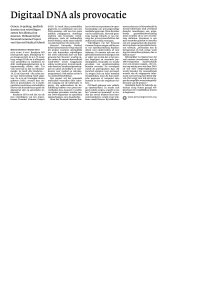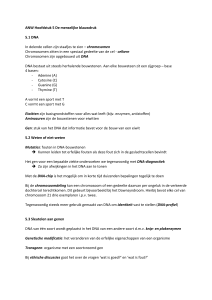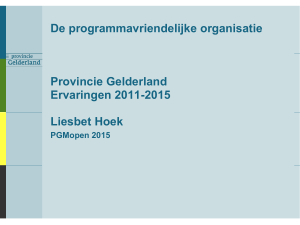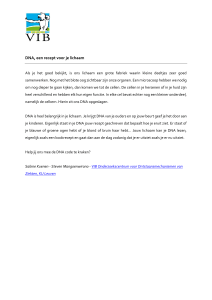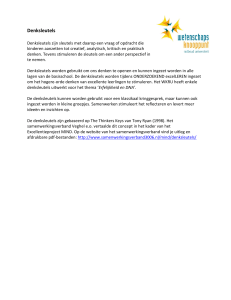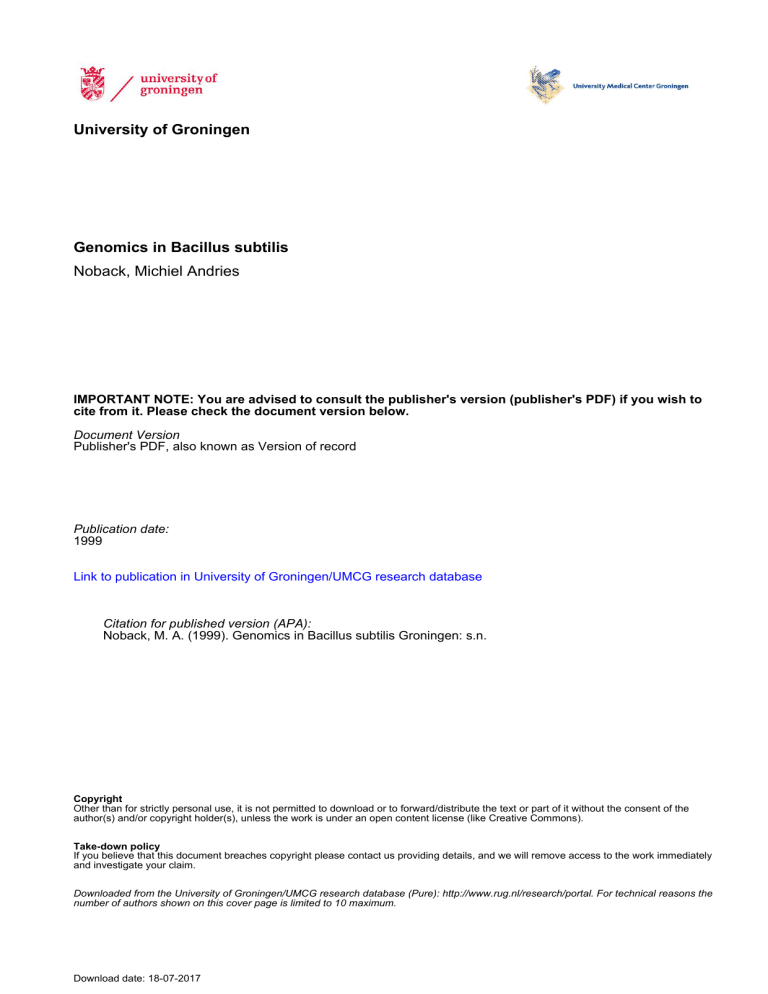
University of Groningen
Genomics in Bacillus subtilis
Noback, Michiel Andries
IMPORTANT NOTE: You are advised to consult the publisher's version (publisher's PDF) if you wish to
cite from it. Please check the document version below.
Document Version
Publisher's PDF, also known as Version of record
Publication date:
1999
Link to publication in University of Groningen/UMCG research database
Citation for published version (APA):
Noback, M. A. (1999). Genomics in Bacillus subtilis Groningen: s.n.
Copyright
Other than for strictly personal use, it is not permitted to download or to forward/distribute the text or part of it without the consent of the
author(s) and/or copyright holder(s), unless the work is under an open content license (like Creative Commons).
Take-down policy
If you believe that this document breaches copyright please contact us providing details, and we will remove access to the work immediately
and investigate your claim.
Downloaded from the University of Groningen/UMCG research database (Pure): http://www.rug.nl/research/portal. For technical reasons the
number of authors shown on this cover page is limited to 10 maximum.
Download date: 18-07-2017
CHAPTER X
Summary and conclusions
Genomics concerns the aquisition of knowledge of structure and function of genomes.
The scope of genomics research is wide; it includes the determination of the nucleotide
sequence of all of an organisms’ DNA, the analysis of the information that resides in it, the
assessment of the functions of the uncovered information and how these functions interact,
and the study of how and why genomes have evolved the way they did.
The first prerequisite for genomics research is the availability of genome sequences,
preferably as complete as possible. The first genome sequence, that of the Gram-negative
pathogenic bacterium Haemophilus influenzae, became available in 1995. It has been
determined using the method called whole-genome random sequencing. The most important
aspect of this strategy is that the genome sequence is determined and assembled from
randomly taken fragments; genetic information of the organism is not needed in advance.
Now, within an interval of just three years, already 19 complete genome sequences are
available, including two eukaryal genomes; those of Saccharomyces cerevisiae and
Caenorhabditis elegans. Within the next decade, many of the most important model
organisms used in biological research will have been determined, including the human
genome which consists of no less then 3×109 bp in the haploid state.
The Bacillus subtilis genome sequencing project was undertaken for several reasons.
This bacterium has already been an important subject of scientific studies for several decades,
serving as a model organism in genetics research, in particular for Gram-positive bacteria,
because it exhibits two “primitive” developmental processes. These are its ability to form
specialised cells (endospores), and its natural capacity to import DNA from the surrounding
medium (competence) and, if homologous DNA is taken up, to incorporate this into its own
chromosome. Furthermore, Bacillus species are widely used in industry for the production of
secreted enzymes such as proteases and amylases.
The B. subtilis genome sequence was determined in a truly international effort, by a
consortium of over 25 research groups from Europe and Japan. A particular region from the
genetic map of the B. subtilis chromosome was assigned to each research group involved in
the project. Our group was initially responsible for sequencing the chromosomal region
between the genetic markers glyB and addAB, estimated to contain 96 kb of DNA. Relatively
large chromosomal clones from this region were obtained through various strategies:
screening of a genome bank in bacteriophage lambda, plasmid walking, long-range and
150 Chapter X
inversed long-range polymerase chain reaction (LR PCR & i-LR PCR). Of these, the two
PCR applications proved to be the most efficient, since they circumvent the -often
troublesome- cloning of large fragments of foreign DNA in Escherichia coli. The sequence of
chromosomal clones was subsequently determined with the aid of one of several random
shotgun approaches, of which the DNaseI shotgun method was proven to be the most
successful.
In total, 171,812 basepairs (bps) were determined in our group, between 83° and 97° on
the circular map of the chromosome, representing 4.1% of the B. subtilis genome. Due to the
erratic original genetic map of this chromosomal region, this was almost twice as much as
was originally foreseen at the onset of the project. We have identified 170 putative genes in
this region, 48 of which could not be assigned a possible function on the basis of their amino
acid similarity to known proteins in the public databases. Analyses of the deduced protein
sequences with respect to compartmentalisation signals revealed that 45% of these were
putative membrane proteins, 4% secreted proteins, 49% cytoplasmatic, and 2% membraneassociated proteins through lipomodification. Many of the putative genes in this region have
one or more paralogs in the B. subtilis genome, and some of these are members of large
paralog families, such as the family of ABC-type transporters and that of DegU-type
transcriptional regulators. The sequencing and subsequent in silico analysis of the region prkA
to addAB are described in Chapters II and III. The complete genome sequence of B. subtilis is
presented in Chapter IV.
Chapter five is an example of in silico genomics at the proteome level. It deals with
the positional analysis of amino acid (aa) frequencies in the deduced proteins of fourteen
complete genomes (proteomes). This has revealed a biased use of many aa’s in the aminoterminal and carboxy-terminal aa positions of these proteomes. Further investigation of these
biases with respect to charge- and hydrophobicity characteristics, showed that all proteomes
display similar differences between the amino- and carboxy-terminus with respect to these
parameters. This could reflect that the N- and C-termini of proteins are usually located at the
surface of proteins, and might be involved in the proper translocation of the nascent proteins
through the ribosome.
Several chapters in this thesis deal with typical examples of functional genomics.
Chapter VI is an example of a straightforward approach. The deduced protein sequence
of yhxB, a gene from within the prkA to addAB region, was found to be highly similar to
phosphoglucomutases from other organisms. From previous studies it was known that a
genetic marker encoding such a function, and being involved in the glucosylation of the cell
wall component teichoic acid, resides in this chromosomal region. We have demonstrated that
yhxB encodes the protein responsible for glucosylation of teichoic acid, that this gene has no
functional paralog in the B. subtilis genome, and that inactivation of the gene rendered the
cells resistant to several bacteriophages.
Chapter VII represents another approach to functional genomics. This chapter deals
with the search for a biological function of an ubiquitous gene, hit, that has orthologs in
Summary and conclusions 151
probably all living organisms. A strain in which this gene was inactivated was subjected to
systematic functional analyses, which included analysis of transcription, regulation,
biochemistry, and phenotype screening. The Hit protein was found to convert ADP in two
ways, the relative amounts of products of the Hit-mediated reaction being dependent on the
pH. Hit hydrolysed ADP to AMP and Pi, and also acted as phosphotransferase in the reaction
2 ADP → ATP + AMP. Phenotype screening revealed that the gene was involved in heatshock protection in B. subtilis. Another ubiquitous gene, yabJ, was observed to be involved in
the regulation of transcription of the hit gene.
In Chapter VIII, the identification of a new forespore-specific gene of B. subtilis is
described. Based on the observed presence of two aa sequence motifs in the deduced protein,
specific for small acid-soluble spore proteins (SASP’s) and membrane-anchored lipoproteins,
we assumed that this gene might be associated with the sporulation process. This assumption
has subsequently been validated. YhcN was shown to be localised in the inner spore
membrane, and inactivation of the gene yielded a strain that was impaired in spore
germination.
Chapter IX deals with a typical example of paralog research. The B. subtilis
chromosome encodes four paralogous type I signal peptidases, responsible for the removal of
signal peptides from secretory precursor proteins. Functional analysis of these signal
peptidase genes and the corresponding proteins revealed that the latter have similar but nonidentical substrate specificities, and that the genes have different expression characteristics.
The sipU and sipV genes are transcribed constitutively at a low level, while transcription of
sipS and sipT is temporally controlled.
The availability of complete genome sequences has already drastically changed the way
in which genetic research is performed. Until recently, when a particular function of an
organism was investigated, a researcher first had to clone the corresponding gene with the aid
of various time-consuming strategies. Today, in the genomics era, a variety of techniques
exists to identify the particular gene in a genome sequence that encodes the function one is
looking for. However, the real added value of genomics lies in several other aspects. First, it
is now feasible to systematically analyse all the (unknown) genes from a genome in either a
simultaneous, or a high-throughput serial approach. Secondly, it now becomes possible to
investigate the regulation of all genes in a genome at once, as well as the interactions between
the encoded proteins and the interactions between the proteins and the genes. The complete
genome sequences also enable researchers to investigate evolutionary relationships between
organisms in a new and exciting way. Finally, major advantages from genomic research are to
be expected in the field of biotechnological and medical application.
152 Chapter X
Samenvatting en conclusies
Genomica omvat het onderzoek aan structuur en functie van genomen. Het werkveld
van de genomica is breed; het omvat de bepaling van de basenvolgorde van het DNA van een
organisme, de analyse van informatie die daarin besloten ligt, de functiebepaling daarvan, de
analyse van de interactie tussen de gevonden informatie-eenheden en de studie van genoomevolutie.
De eerste voorwaarde voor het bedrijven van genoom-onderzoek is de beschikbaarheid
van, bij voorkeur complete, genoomvolgordes. De eerste genoomvolgorde, die van de Gramnegatieve pathogene bacterie Haemophilus influenzae, kwam beschikbaar in 1995. Deze werd
bepaald door middel van de methode “whole-genome random sequencing”. Het belangrijkste
aspect van deze strategie is dat de basenvolgorde van willekeurige DNA fragmenten bepaald
wordt; genetische informatie over het organisme is niet nodig. Nu, slechts iets meer dan drie
jaar later, zijn al 19 complete genoomvolgordes bekend, waaronder de eukaryote genomen
van Saccharomyces cerevisiae en Caenorhabditis elegans. Binnen het komende decennium
zullen vele van de belangrijkste model organismen voor biologisch onderzoek bekend zijn op
nucleotide niveau, waaronder het in haploide vorm niet minder dan 3×109 basenparen tellende
genoom van de mens.
Het project voor de bepaling van de genoomvolgorde van Bacillus subtilis werd
ondernomen om meerdere redenen. Deze bacterie, die model staat voor Gram-positieve
bacteriën, is al meerdere decennia een belangrijk onderwerp van wetenschappelijk onderzoek,
niet in het minst omdat het twee “primitieve” ontwikkelingssystemen kent, namelijk het
vermogen om gespecialiseerde cellen (endosporen) te vormen, en het natuurlijke vermogen
om DNA uit het omringende medium op te nemen (competentie) en, als het soortseigen DNA
betreft, dit vervolgens in het eigen chromosoom te incorporeren. Verder worden verschillende
Bacillus soorten veelvuldig in de industrie gebruikt voor de produktie van gesecreteerde
enzymen, zoals proteasen en amylasen. De sequentie van het B. subtilis genoom werd in een
geïntegreerd international samenwerkingsverband bepaald door een consortium van meer dan
25 onderzoeksgroepen uit Europa en Japan. Iedere participerende onderzoeksgroep kreeg een
bepaald gebied op de genetische kaart van het B. subtilis chromosoom toegewezen. Onze
groep werd bij het begin van het project het gebied tussen de genetische merkers glyB en
addAB toegewezen, hetgeen naar schatting 96 kb DNA zou omvatten. Relatief grote
chromosomale fragmenten werden verkregen door gebruik te maken van één van de volgende
strategieën: Screenen van een genomische bank in bacteriofaag lambda, “plasmid walking”,
lange-afstands-PCR en omgekeerde lange-afstands-PCR (LR PCR & i-LR PCR). De twee
PCR toepassingen bleken het meest succesvol, omdat hiermee het -meestal problematischekloneren van grote soortsvreemde DNA fragmenten in E. coli kon worden omzeild. De
volgorde van chromosomale klonen werd vervolgens bepaald met behulp van één van een
aantal mogelijke “shotgun” technieken, waarvan de DNaseI “shotgun” techniek het meest
succesvol is gebleken.
Summary and conclusions 153
In totaal werden door onze groep 171.812 basenparen (bps) bepaald van het gebied
tussen 83° en 97° op de circulaire kaart van het chromosoom; dit komt overeen met 4,1% van
het genoom van B. subtilis. Dit is bijna twee keer zoveel als bij het begin van het project was
voorzien omdat de oorspronkelijke genetische kaart van dit chromosomale gebied grote
fouten bleek te bevatten. In dit gebied werden 170 mogelijke genen geïdentificeerd, waarvan
aan 48 geen mogelijke functie toegewezen kon worden op basis van de gelijkenis van de van
hun sequentie afgeleide aminozuur volgorde met bekende eiwitten in de publieke databanken.
Analyse van de compartimentalisatie signalen in de afgeleide aminozuur volgordes liet zien
dat naar schatting 45% van de eiwitten membraaneiwit is, 4% wordt gesecreteerd, 49%
cytoplasmatisch is en 2% membraan-geassocieerd is door middel van lipomodificatie. Veel
van de genen in dit gebied hebben één of meerdere paralogen in het B. subtilis genoom en
sommige van de afgeleide eiwitproducten zijn leden van een grote familie van paralogen,
zoals de familie van ABC-type transporters of de familie van DegU-type transcriptionele
regulatoren. De DNA volgorde bepaling en de daaropvolgende in silico analyses van het
chromosomale gebied tussen prkA en addAB worden beschreven in de Hoofdstukken II en III.
De complete genomische DNA volgorde van B. subtilis staat beschreven in Hoofdstuk IV.
Hoofdstuk V is een voorbeeld van in silico genomica op het proteoom niveau. Het
behandelt de positionele analyse van aminozuur frequenties in de afgeleide eiwitvolgordes
van veertien bekende genomen (proteomen). Deze analyse liet een onder-, c.q. overrepresentatie van vele aminozuren zien in de amino- en carboxy-terminale posities van deze
proteomen. Verdere analyse van deze “biases” met betrekking tot de ladings- en
hydrofobiciteits-eigenschappen liet zien dat alle proteomen vergelijkbare verschillen vertonen
in deze eigenschappen tussen de amino- en carboxy-terminus. Dit kan een gevolg zijn van het
feit dat N- en C- termini van eiwitten gewoonlijk aan de buitenkant gelokaliseerd zijn, maar
ook van de wijze waarop het eiwitmolecuul door het ribosoom wordt getransporteerd.
Verschillende hoofdstukken in dit proefschrift behandelen typische voorbeelden van
functionele genomica.
Hoofdstuk VI is een voorbeeld van een directe benadering. De afgeleide eiwitvolgorde
van yhxB, een gen uit het prkA-addAB gebied, bleek grote overeenkomst te vertonen met
fosfoglucomutasen uit andere organismen. Uit eerder onderzoek was bekend dat genetische
informatie voor een dergelijke functie, betrokken bij de glucosylering van de celwandcomponent teichoïnezuur, gelegen moest zijn in dit deel van het chromosoom. Wij hebben
aangetoond dat yhxB het eiwit specificeert dat verantwoordelijk is voor de glucosylering van
teichoïnezuur, dat het geen functionele paraloog in het B. subtilis genoom heeft en dat de
inactivatie van dit gen de cellen resistent maakt tegen een aantal bacteriofagen.
Het onderzoek beschreven in hoofdstuk VII heeft betrekking op een andere benadering
in functionele genomica. Dit hoofdstuk behandelt de zoektocht naar een biologische functie
van een universeel gen, hit, dat orthologen heeft in waarschijnlijk alle levende organismen.
Een stam waarin dit gen was uitgeschakeld werd onderworpen aan systematische functionele
analyses, die ondermeer de analyse van de transcriptie, de regulatie, en het zoeken naar een
154 Chapter X
fenotype en de biochemische functie inhield. Het Hit eiwit bleek ADP op twee manieren te
kunnen omzetten, waarbij de onderlinge verhoudingen van de door Hit gevormde producten
afhankelijk waren van de pH. Hit hydrolyseert ADP tot AMP en Pi, maar werkt ook als
fosfotransferase in de reactie 2 ADP → ATP + AMP. Fenotype screening toonde aan dat het
hit gen betrokken was bij bescherming tegen hitte-schok in B. subtilis. Verder bleek dat een
ander, waarschijnlijk ook universeel gen, yabJ, betrokken was bij de transcriptie regulatie van
het hit gen.
In hoofdstuk VIII wordt de identificatie van een nieuw voorspore-specifiek gen van B.
subtilis beschreven. Gebaseerd op de waarneming dat de afgeleide eiwitvolgorde van dit gen
twee sequentie motieven bevatte die specifiek zijn voor “small acid soluble proteins”
(SASP’s) en membraan-verankerde lipo-eiwitten, werd aangenomen dat dit gen betrokken zou
kunnen zijn bij het sporulatie proces. Deze aanname werd bevestigd. Het YhcN eiwit werd in
de binnenste sporemembraan aangetoond en door inactivatie van het gen werd de sporeontkieming van de corresponderende stam minder efficiënt.
Hoofdstuk IX betreft een typisch voorbeeld van paralogen onderzoek. Het B. subtilis
chromosoom specificeert vier paralogen van type I signaal peptidasen, die verantwoordelijk
zijn voor de verwijdering van signaal peptides van uitgescheiden eiwitten. De functionele
analyse van deze genen en hun corresponderende eiwitten toonde aan dat deze eiwitten
overeenkomstige, maar niet volstrekt identieke, substraat specificiteiten bezitten en dat de
genen verschillend tot expressie komen: de genen sipU en sipV worden constitutief
getranscribeerd op een laag niveau, terwijl sipS en sipT temporeel worden gereguleerd.
De beschikbaarheid van de nucleotidenvolgordes van genomen heeft de manier waarop
genetisch onderzoek wordt gedaan nu reeds drastisch veranderd. Tot voor kort moest een
onderzoeker, wanneer een bepaalde functie van een organisme werd onderzocht, het
corresponderende gen met behulp van verschillende tijdrovende klonerings-strategieën in
handen zien te krijgen. Tegenwoordig, in het genomica-tijdperk, bestaat er een
verscheidenheid aan -minder tijdrovende- technieken om het specifieke gen te identificeren
dat voor de functie die men zoekt verantwoordelijk is. De echte toegevoegde waarde van de
genomica ligt echter in een aantal andere aspecten. Ten eerste is het nu mogelijk om
systematisch alle (onbekende) genen van een genoom op een seriële “high-throughput”
manier, te analyseren. Ten tweede wordt het nu mogelijk de regulatie van alle genen in een
genoom gelijktijdig te onderzoeken, evenals de interacties tussen de gevormde eiwitten en de
interacties tussen de eiwitten en de genen. Tevens maken complete genoomvolgordes het de
onderzoeker mogelijk om evolutionaire verwantschappen tussen organismen te onderzoeken
op een nieuwe, spannende, manier. Tenslotte ligt het in de verwachting dat genomisch
onderzoek van groot belang zal zijn voor biotechnologische en medische toepassingen.


